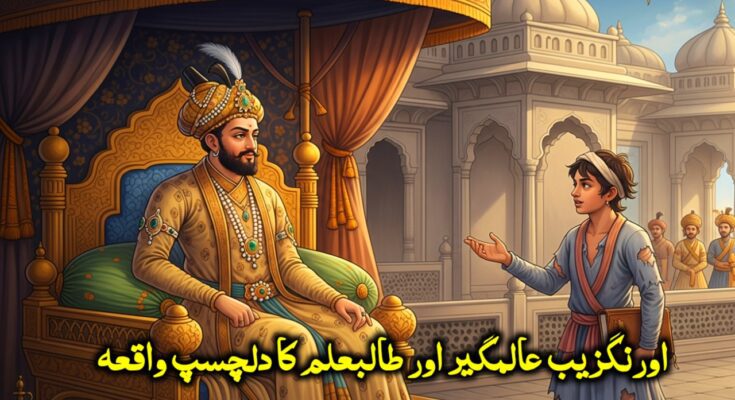Aurangzeb Alamgir aur Talib-e-Ilm ka Dilchasp Waqia – A Historical Urdu Story
Aurangzeb Alamgir aur Talib-e-Ilm ka Dilchasp Waqia – A Historical Urdu Story is a fascinating tale of wit and wisdom. When a poor student faces tricky questions from the emperor’s minister, his clever answers leave everyone amazed. This inspiring Urdu Story proves that true strength lies in knowledge and intelligence, not wealth or power.
بادشاہ اورنگ زیب عالمگیر ایک دن دہلی میں اپنے مثمن برج میں بیٹھے تھے کہ ایک طالبِ علم وہاں سے گزرا۔ اس کا حال یہ تھا کہ جوتیاں ٹوٹی ہوئی تھیں، کپڑے پھٹے ہوئے تھے اور کتاب بغل میں دبی ہوئی تھی۔
One day, Emperor Aurangzeb Alamgir was sitting in his octagonal pavilion in Delhi when a student passed by. His condition was such that his shoes were broken, his clothes were torn, and a book was tucked under his arm.
بادشاہ نے اپنے وزیر سے پوچھا: ’’یہ کون ہے؟‘‘ وزیر نے تحقیر آمیز لہجے میں کہا: ’’جہاں پناہ! یہ مولویوں کی قوم کا فرد ہے، جو علم کا دعویٰ تو کرتی ہے مگر کسی کام کی نہیں۔‘‘
The emperor asked his minister, “Who is this?” The minister replied scornfully, “Your Majesty, he belongs to the community of scholars who claim to possess knowledge but are of no real use.”
یہ سن کر اورنگ زیب نے کہا: ’’اگر یہ سچا طالبِ علم ہے تو تم جیسے ہزاروں کو بیچ کھائے گا اور تمہیں خبر بھی نہ ہوگی۔‘‘ وزیر نے طنزیہ انداز میں کہا: ’’حضور! یہ آپ کی خوش اعتقادی ہے۔‘‘ بادشاہ نے فرمایا: ’’اچھا! امتحان کر لو۔‘‘
Hearing this, Aurangzeb said, “If he is a true student of knowledge, he could surpass thousands like you without your even knowing.” The minister mockingly replied, “Your Majesty, that is mere wishful thinking.” The emperor responded, “Very well, then test him.”
چوبدار کو بلا کر حکم دیا گیا کہ اس طالبِ علم کو حاضر کیا جائے۔ جب وہ آیا تو وزیر نے سوالات شروع کیے۔ پہلا سوال یہ تھا: ’’یہ حوض جو یہاں ہے، اس میں کتنے کٹورے پانی ہے؟‘‘
The guard was summoned and ordered to bring the student before the emperor. When he arrived, the minister began questioning him. The first question was: “This pond here, how many bowls of water does it contain?”
طالبِ علم نے مسکراتے ہوئے جواب دیا: ’’یہ تو آپ پر ہے کہ کٹورا کتنا بڑا ہے۔ اگر آدھا حوض ایک کٹورا ہے تو دو کٹورے پانی ہیں، اگر تہائی ہے تو تین، اور اگر چوتھائی ہے تو چار۔‘‘ یہ سن کر بادشاہ ہنس پڑے اور وزیر لاجواب ہو گیا۔
The student smiled and replied, “That depends on how large you define the bowl to be. If half the pond equals one bowl, then it contains two bowls of water. If a third equals a bowl, then three; and if a quarter, then four.” Hearing this, the emperor laughed, and the minister was left speechless.
پھر وزیر نے دوسرا سوال کیا: ’’اس زمین کا بالکل بیچ کہاں ہے؟‘‘ طالبِ علم نے اپنی پگڑی اتاری اور زمین ناپنا شروع کر دیا۔ چاروں طرف برابر ناپ کر بیچ میں کھونٹی گاڑ دی اور کہا: ’’یہ ہے زمین کا بیچ۔ اگر یقین نہ آئے تو آپ خود ناپ لیجیے۔‘‘
Then the minister asked a second question: “Where is the exact center of this land?” The student removed his turban and began measuring the ground. After pacing equal steps from all sides, he placed a peg in the middle and said, “Here lies the center of the land. If you doubt it, measure it yourself.”
یہ جواب سن کر بادشاہ اورنگ زیب زور سے ہنس پڑے اور کہا: ’’وزیر صاحب! آپ نے طالبِ علم کو پھانسنے کی کوشش کی مگر خود ہی پھنس گئے۔‘‘
Hearing this answer, Emperor Aurangzeb burst into laughter and said, “Minister! You tried to trap the student, but it is you who has been trapped.”
یہ واقعہ اس بات کا ثبوت ہے کہ اصل طاقت دولت یا عہدے میں نہیں بلکہ علم اور ذہانت میں ہے۔
This incident proves that true power does not lie in wealth or status, but in knowledge and intelligence.



